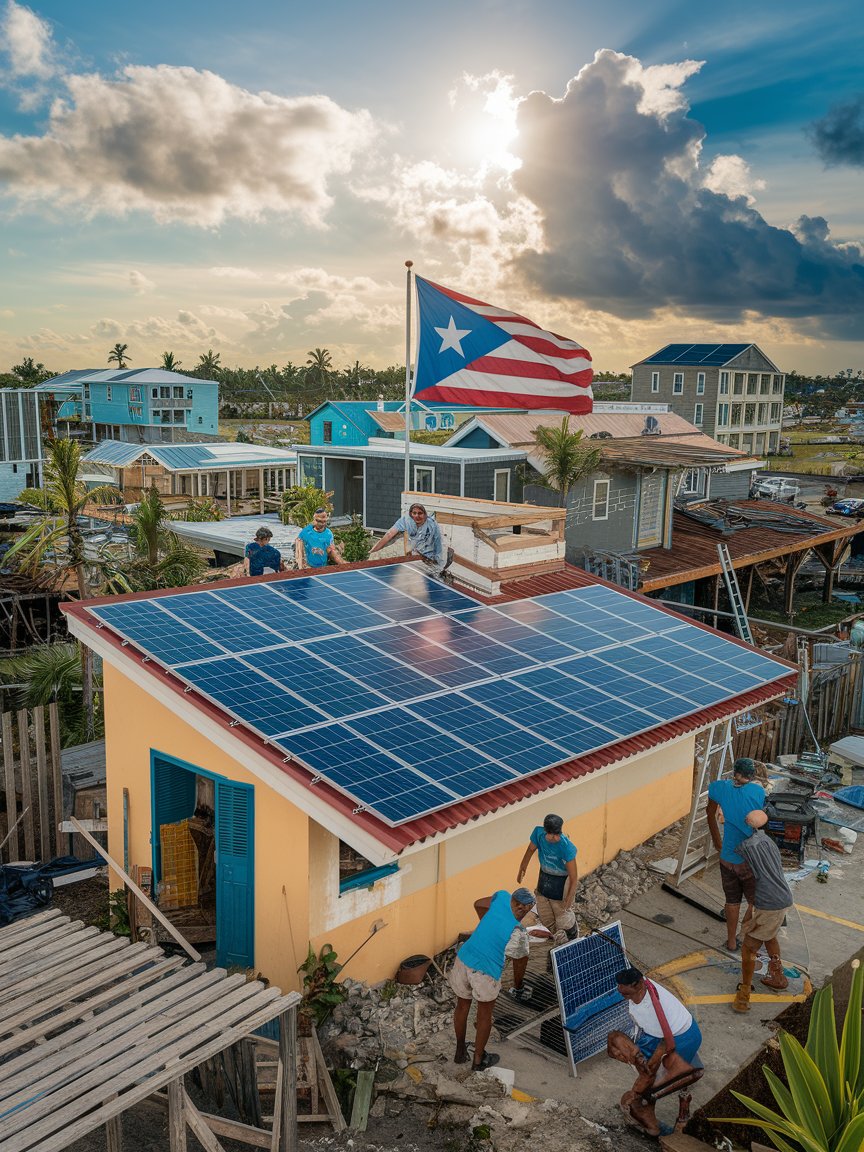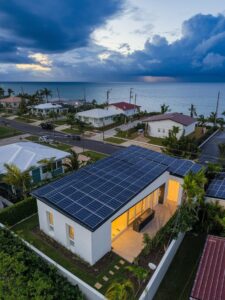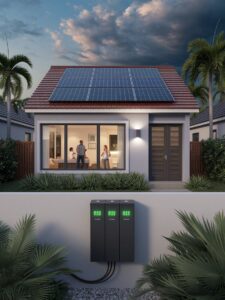
When Hurricane Maria made landfall in Puerto Rico on September 20, 2017, it unleashed unprecedented destruction upon the island’s infrastructure, most notably its electrical grid. The catastrophic failure of Puerto Rico’s centralized power system—which left 1.5 million residents without electricity for months—became a stark illustration of the vulnerability of traditional energy systems to extreme weather events. This crisis, though devastating, created an unexpected opportunity: the chance to reimagine and reconstruct Puerto Rico’s energy landscape from the ground up. In the years since, solar energy has emerged as a cornerstone of the island’s recovery strategy, offering not just a renewable alternative to fossil fuels but a pathway to energy sovereignty and economic revitalization. Green Power Solar Systems has been at the forefront of this transformation, working alongside communities, businesses, and government agencies to implement solar solutions tailored to Puerto Rico’s unique needs and challenges. This blog explores the multifaceted role solar energy plays in Puerto Rico’s ongoing recovery—from strengthening critical infrastructure and creating local jobs to fostering community resilience and environmental sustainability. The island’s journey offers valuable lessons about rebuilding with purpose and how renewable energy can serve as both practical solution and powerful symbol of hope.
H2 Section 1: The Legacy of a Fragile Grid (2 paragraphs, 150 words)
The Legacy of a Fragile Grid
Prior to Hurricane Maria, Puerto Rico’s electrical system was already in a precarious state. The island’s power authority, PREPA, was burdened with aging infrastructure, $9 billion in debt, and decades of deferred maintenance. Power generation relied heavily on imported fossil fuels, with approximately 98% of electricity produced from oil, coal, and natural gas. This dependence not only resulted in some of the highest electricity rates in the United States but also created a system vulnerable to global fuel price fluctuations and supply chain disruptions.
The grid’s physical configuration compounded these vulnerabilities. Large power plants concentrated in the southern region generated electricity that had to travel across mountainous terrain via transmission lines to reach population centers in the north. This centralized design meant that damage to key transmission points could—and did—cause cascading failures across the entire system. When Hurricane Maria’s winds toppled thousands of utility poles and destroyed hundreds of miles of transmission lines, the result was the second-longest blackout in world history. Green Power Solar Systems’ assessment teams documented critical infrastructure operating without reliable power for more than 11 months in some remote areas.
H2 Section 2: Solar as a Recovery Strategy (3 paragraphs, 225 words)
Solar as a Recovery Strategy
In the immediate aftermath of Hurricane Maria, solar energy emerged as a crucial emergency response tool. Portable solar generators and rapidly deployed panel systems provided power for critical needs while conventional grid restoration efforts struggled with logistical challenges. Organizations including Green Power Solar Systems airlifted lightweight solar equipment to remote communities, establishing temporary power stations for charging medical devices, communications equipment, and water purification systems. These emergency installations demonstrated solar power’s unique advantages during crisis response: immediate deployment, operation independent of fuel supply chains, and resilience against cascading infrastructure failures.
As recovery efforts transitioned from emergency response to long-term rebuilding, solar energy’s role expanded accordingly. The Federal Emergency Management Agency (FEMA) and the Department of Housing and Urban Development (HUD) allocated billions toward Puerto Rico’s energy infrastructure reconstruction, with specific provisions encouraging renewable energy adoption. Local legislation, including Act 17-2019, established ambitious goals of 40% renewable energy by 2025 and 100% by 2050, creating a supportive policy environment for solar development. These combined factors accelerated what might otherwise have been decades of energy transition into a compressed timeline of urgent implementation.
Green Power Solar Systems has participated in this transition through projects spanning from residential rooftop installations to utility-scale solar farms. Our data indicates that solar capacity on the island has increased more than fivefold since 2017, with particularly strong growth in distributed generation systems that provide resilience at the household and community level. This growth represents not just kilowatts of clean energy capacity but a fundamental rethinking of how Puerto Rico generates, distributes, and values electrical power within its unique geographical and economic context.
H2 Section 3: Critical Infrastructure Resilience (2 paragraphs, 160 words)
Critical Infrastructure Resilience
Among the most vital applications of solar energy in Puerto Rico’s recovery has been strengthening essential services against future disruptions. Hospitals, water treatment facilities, telecommunications centers, and emergency response stations have increasingly incorporated solar plus storage systems to ensure continuous operation regardless of grid conditions. These installations typically function as hybrid systems—remaining connected to the utility grid during normal operations but capable of “islanding” to operate independently during outages. Green Power Solar Systems has completed over forty such projects for critical facilities across the island, designing each system to meet the specific operational requirements and space constraints of the facility.
The Costa Salud Community Health Center in Rincón exemplifies this approach. After operating on unreliable diesel generators for months following Hurricane Maria, the facility partnered with Green Power Solar Systems to install a comprehensive solar microgrid. The 87 kW system includes battery storage sized to maintain essential medical equipment for up to 72 hours without sunshine, ensuring uninterrupted care for patients even during extended weather events. Similar systems now protect dialysis centers, emergency shelters, and food distribution facilities, forming a network of solar-powered resilience hubs across the island.
H3 Subsection: Case Study – Adjuntas Microgrids (3 paragraphs, 210 words)
Case Study: Adjuntas Microgrids
The mountain town of Adjuntas, located in Puerto Rico’s interior highlands, faced particularly severe challenges after Hurricane Maria. The community’s remote location and difficult terrain meant grid restoration progressed slowly, leaving residents without power for nearly eleven months. During this extended outage, the local non-profit organization Casa Pueblo—which had installed a small solar system years before the hurricane—became a critical community lifeline, providing power for refrigeration of medicines, communications equipment, and device charging. This experience catalyzed a vision for expanding solar access throughout the community.
In 2019, Green Power Solar Systems partnered with Casa Pueblo and the Adjuntas municipal government to develop a comprehensive solar microgrid network connecting the town’s central business district. The project, completed in 2021, links 13 businesses through a shared solar array and battery storage system capable of operating independently from the main grid. During normal conditions, the microgrid optimizes energy flows between buildings, reducing overall consumption. During outages, the system prioritizes critical services while maintaining basic operations for all connected businesses.
The Adjuntas microgrid has transformed the community’s relationship with energy, creating what residents call an “energy oasis” that strengthens local economic resilience. Businesses connected to the microgrid report 30-40% reductions in operating costs, allowing them to invest in expansion and employee retention. Perhaps most significantly, the project is structured as a community-owned cooperative, with profits from energy management reinvested in expanding solar access to residential areas. This model of community energy sovereignty has since been replicated in seven additional municipalities across Puerto Rico.
H2 Section 4: Economic Revitalization Through Clean Energy (2 paragraphs, 150 words)
Economic Revitalization Through Clean Energy
Beyond providing resilient power, Puerto Rico’s solar expansion has become a significant economic engine. The sector has created thousands of jobs across the value chain—from system design and installation to maintenance and monitoring services. Green Power Solar Systems alone has expanded from 12 employees pre-Maria to over 85 currently, with 90% of new hires coming from local communities. These positions offer competitive wages and skill development in a growth industry, providing stable employment opportunities in regions previously dependent on declining agricultural sectors.
The economic benefits extend beyond direct employment. Studies by the University of Puerto Rico’s Center for a New Economy indicate that every dollar invested in renewable energy on the island generates approximately $1.80 in economic activity through reduced energy costs, construction spending, and workforce development. Additionally, businesses with solar installations report improved operational stability and reduced overhead, allowing them to weather economic fluctuations more effectively. For an island still recovering from multiple economic shocks—including a debt crisis that preceded Hurricane Maria—this renewable energy sector growth represents a crucial diversification of the economic landscape.
H2 Section 5: Community Empowerment Through Energy Independence (2 paragraphs, 140 words)
Community Empowerment Through Energy Independence
Perhaps the most transformative aspect of Puerto Rico’s solar movement has been its democratization of energy production and distribution. In contrast to the previously centralized system controlled by a single entity, solar technology enables individuals and communities to generate their own power, creating what energy democracy advocates call a “prosumer” model—where residents are both producers and consumers of electricity. Green Power Solar Systems has facilitated this transition through innovative financing models that make solar accessible across income levels, including power purchase agreements requiring no upfront investment and community solar arrangements allowing multiple households to share the benefits from a single installation.
This shift toward energy sovereignty has profound implications beyond technical resilience. Communities with local generation capacity report greater social cohesion and civic engagement, as energy management becomes a shared responsibility rather than a service provided by distant authorities. Neighborhood energy committees have formed in regions with high solar penetration, creating new forums for collective decision-making and resource allocation. These emerging governance structures represent a reclaiming of agency by communities that historically had little influence over their energy systems.
H2 Section 6: Looking Forward: Challenges and Opportunities (3 paragraphs, 210 words)
Looking Forward: Challenges and Opportunities
Despite remarkable progress, Puerto Rico’s solar transformation faces significant challenges. Integration of distributed resources with the recovering main grid requires substantial investments in advanced control systems and energy management technologies. Regulatory frameworks developed for conventional generation sometimes create unintended barriers to innovative projects, particularly community-scale microgrids that blur traditional distinctions between utilities and consumers. Additionally, solar deployment has progressed unevenly across socioeconomic lines, with higher-income areas achieving greater adoption rates than disadvantaged communities that could benefit most from energy cost reductions.
Green Power Solar Systems continues working to address these challenges through technological innovation and policy advocacy. Our “Solar for All” initiative pairs every commercial installation with a subsidized system for a low-income household, helping to democratize access to renewable energy benefits. We’ve also developed specialized financing products for small businesses and agricultural operations, sectors crucial to Puerto Rico’s economy that often struggle to access conventional solar financing. These approaches aim to ensure that the benefits of Puerto Rico’s energy transformation are shared equitably across society.
Looking ahead, Puerto Rico stands at the forefront of a global energy transition accelerated by climate awareness and technological advancement. The knowledge and experience developed through the island’s recovery process—integrating high levels of distributed generation, operating islandable microgrids, and engaging communities in energy planning—offer valuable lessons for regions worldwide facing similar climate vulnerabilities and grid reliability challenges. What began as disaster recovery has evolved into a leading laboratory for the resilient, renewable energy systems of the future.
Conclusion with call-to-action (70 words)
Puerto Rico’s journey from devastation to renewable transformation demonstrates how crisis can catalyze positive systemic change. Green Power Solar Systems remains committed to this ongoing transition, partnering with communities to build energy systems that withstand future challenges while delivering daily benefits. Contact our team today to learn how your home, business, or community can participate in building a more resilient Puerto Rico powered by the abundant Caribbean sun.





No comment yet, add your voice below!